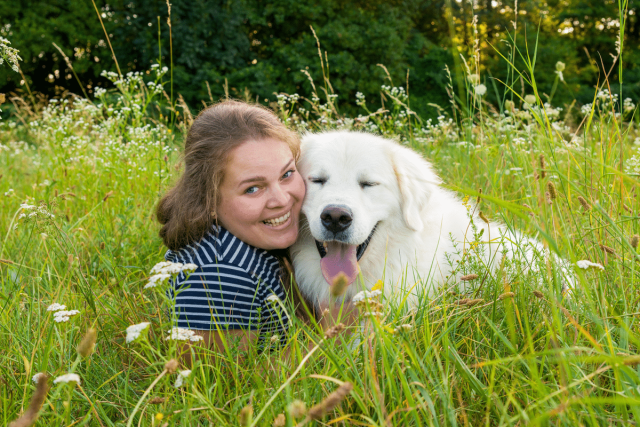What is an allergy? An allergy is the result of an overactive immune system. Normally, our immune system protects us from actual threats such as bacteria and viruses. Allergic reactions occur when the immune system mistakes non-harmful environmental substances (allergens) as threats. The same holds true for our pets. A dog with allergies will have an extreme reaction to an allergen that is harmless to most animals. Do you suspect your dog suffers from allergies? Are some breeds more prone to allergies than others? What can you do to help treat or even prevent allergies in your dog? Read on for these answers and much more!

Symptoms
Allergens can be either inhaled, ingested, or may simply come in contact with a dog’s skin. Depending on how your dog encounters the substance and how they react to the allergen, a variety of skin, digestive, and respiratory symptoms may occur.
Here are some of the most common allergy symptoms in dogs:
-Itchy, red, moist, oozing or scabbed skin
-Increased scratching
-Itchy, runny eyes
-Itchy back or base of tail (most commonly flea allergy)
-Itchy or inflamed ears and chronic ear infections
-Sneezing
-Vomiting
-Diarrhea
-Snoring caused by an inflamed throat
-Paw chewing/swollen paws
-Constant licking
-Coughing or sneezing; asthma
-Nasal discharge
-Allergic dogs may also suffer from secondary bacterial or yeast skin infections, which may cause hair loss, scabs or crusts on the skin.
Only a veterinarian can determine whether or not your dog has allergies and do testing to confirm the source of the allergy. Your vet may be able to make a diagnosis based on a physical exam and a complete history, but it may require blood or skin tests or a food elimination diet to find out what’s causing your dog’s allergic reactions. While you shouldn’t automatically hop onto a drug regimen suggested by a vet, it is still a good idea to have your dog tested. Many drugs simply mask the symptoms of allergies without addressing the root cause, and certain drugs used to stop the allergic cycle can have serious side effects.
Most dog allergies fall into 3 categories: Flea Allergy Dermatitis (FAD), environmental, and food. Let’s look more closely at the causes and treatments for each of these.

Flea Allergy Dermatitis (FAD)
Flea Allergy Dermatitis is a sensitivity to flea saliva and is very common in dogs. It’s the flea’s saliva that causes most of the itching as opposed to the bite itself. This results in irritation that’s out of proportion to the actual number of fleas on your dog, which means that your dog can be made miserable by just one or two fleas.
Related: Best Dog Allergy Supplements
Many dog parents assume that a dog would have to be severely infested with fleas to be so itchy, but for a dog with FAD, the saliva from just a couple of flea bites can make him miserable, itchy, and uncomfortable for several weeks, even after the fleas have died.
There are lots of flea and tick preventatives and treatments on the market. Each one has its own benefits and downsides. If you have a dog with FAD, regular prevention might not be enough since even a single flea can make your dog miserable. It’s a good idea to buy a flea comb and run it through your dog daily during the peak of flea season. Do this over a white or light towel so you can see what’s coming off your dog as you comb. Flea dirt (which is actually the excrement from fleas) will look like real dirt while it’s on your dog, but if you place it in water or rubbing alcohol, it will dissolve and turn red since it’s basically dried blood. Bathing your dog frequently with a gentle shampoo that is formulated for dogs and preferably doesn’t contain any grains or oatmeal (which can be another allergen) can also help kill fleas and calm your dog’s skin.

Environmental Allergens (Atopy)
There’s a nearly limitless amount of things in the environment that your dog may have or develop an allergy to. Some of the most common environmental allergens include:
-Tree, grass, and weed pollen
-Mold spores
-Dust and house dust mites
-Dander
-Feathers
-Cigarette smoke
-Prescription drugs
-Perfumes
-Cleaning products
-Fabrics
-Insecticidal shampoo
-Rubber and plastic materials
Generally speaking, if your dog is allergic to something inside your house, he’ll have symptoms all year long. Outdoor allergies tend to be more seasonal. If it turns out your dog has an environmental allergy, you’ll want to do everything you can to reduce that allergen inside your home. This may include washing your pet’s bedding at least once a week and vacuuming at least twice a week, including rugs, curtains, and other places that gather dust. Weekly bathing may help remove environmental allergens and pollen from your dog’s skin. Use the gentlest dog shampoo you can find or talk to your vet about a prescription shampoo, since frequent bathing can dry out your dog’s skin. Foot soaks can also help reduce the amount of allergens your dog tracks in from outside in between baths.
Other ways to reduce your dog’s exposure to environmental allergens include switching to non-toxic cleaning products, investing in an air purifier to control dust mites, and not smoking around your dog. Make sure your dog’s drinking water is high quality and doesn’t contain contaminants, fluoride, or heavy metals. Environmental allergens can be managed but are never cured. Your dog will always be allergic to the environmental allergen, so it’s up to you and your vet to come up with a plan for helping your dog manage his allergy.

Food Allergies
Regardless of your pet’s age, they can develop a food allergy at any point in their life. This is especially likely to happen if you’ve been feeding them the same food for months or years. Dogs need diversity in their diets. Your dog might be allergic to the single source of chemically-laced protein she’s been getting (the meat in commercial dog food tends to be loaded with antibiotics and hormones, which can cause an immune system over-reaction). They might also become sensitive to other ingredients in the food, usually grains and other carbohydrates.
The only way to diagnose and treat a food allergy is to feed your dog a prescription on hydrolyzed protein diet – and nothing else – for 12 weeks. This allows the allergen to be completely removed from your dog’s system and gives them a chance for their body to recover. It is extremely important to stick to this diet – any additional treats could set back your dog’s recovery until you know for sure what your dog is allergic to. After 12 weeks, you can begin to reintroduce foods very slowly to see what your dog might be reacting to. Dogs with food allergies may benefit from switching to one of the 11 Best Dog Foods For Allergies.
Breeds at Risk for Allergies
While any breed of dog may be affected by allergies, some dog breeds are more likely to develop allergies than others. Here are some of the breeds most affected by allergies.
-Golden Retriever
-Labrador Retriever
-German Shepherd
-Cocker Spaniel
-Boxer
-Bichon Frise
-Terriers
-Setters
-Pug
-Boston Terrier
-English Bulldog

Drug Treatment Options
Sometimes it isn’t enough to try to reduce the allergen your dog comes in contact with. Sometimes it’s impossible to remove the allergen. Once all other options have been explored, it may be time to talk to your vet about other treatment options.
Dogs with airborne allergies may benefit from allergy injections. These help your pet develop resistance to the allergen instead of just masking the itch. Some dogs may benefit from antihistamines such as Benadryl. Fatty acid supplements may help relieve itchy skin. Certain shampoos may help prevent skin infections, which are common in dogs with allergies. Immune-modulating drugs may be beneficial. In the case of severe allergies, you may have to resort to using corticosteroids such as Prednisone or Triamcinolone to control the allergy. These drugs are strong and may have serious side effects and should be used with caution under the guidance of your veterinarian.
Watching your dog suffer from allergies can be heart-wrenching, but luckily there are many things that can help. It may be a long road to determine what your dog is allergic to and how best to treat the allergy, but with a little bit of persistence, your dog can be feeling better and have a great quality of life. The information in this article is intended to be the beginning of your research into dog allergies and should not take the place of information from your trusted veterinarian.
 Toledo, United States.
Toledo, United States.
